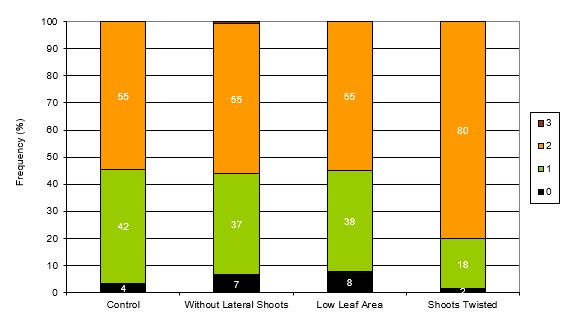L’effetto di diverse forme di gestione e altezza della parete fogliare in sistemi di allevamento a spalliera sulla maturazione dell’uva e la qualità dei vini
Abstract
L’obiettivo di questo lavoro è stato di indagare, in sistemi di allevamento a spalliera, l’effetto sull’accumulo di zuccheri ed altri costituenti nelle uve e sulla qualità dei vini, da parte di diverse forme di gestione della parete fogliare. Per la prova sono stati individuati quattro siti, due siti a vigoria elevata e altri due a vigoria ridotta, con allestite quattro diverse tesi. Il “Testimone” è stato trattato in maniera usuale per la zona, nella variante “senza polloni” questi sono stati eliminati continuamente, nella tesi “parete fogliare ridotta” la parete fogliare è stata mantenuta 50 cm più bassa rispetto al testimone e nella tesi “tralci arrotolati” questi non sono stati cimati, bensì arrotolati orizzontalmente attorno ai fili superiori della parete fogliare. La variante “parete fogliare ridotta” ha mostrato solo effetti limitati sui parametri di maturità, soprattutto nei siti a vigoria ridotta. La qualità di vino di questa tesi non è mai stata giudicata superiore, ma più volte è stata meno apprezzata rispetto al testimone. Inoltre, questa tesi ha rivelato una tendenza a note da invecchiamento atipico dei vini ed in parte è stato osservato una presenza elevata di avvizzimento del grappolo. La tesi dei “tralci arrotolati” invece ha evidenziato livelli di azoto prontamente assimilabile più alti rispetto al testimone soprattutto nei siti ad elevato vigore e ha migliorato la fertilità delle piante.DOI:
https://doi.org/10.23796/LJ/2024.007
##submission.downloads##
Pubblicato
04.04.2024
Come citare
Haas, F., Struffi, I., Pedri, U., & Sanoll, C. (2024). L’effetto di diverse forme di gestione e altezza della parete fogliare in sistemi di allevamento a spalliera sulla maturazione dell’uva e la qualità dei vini. Laimburg Journal, 6. https://doi.org/10.23796/LJ/2024.007
Fascicolo
Sezione
Articoli



